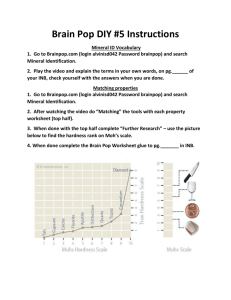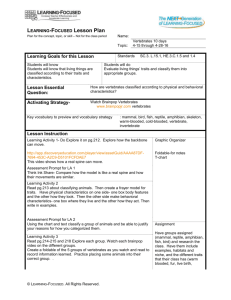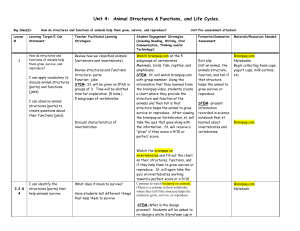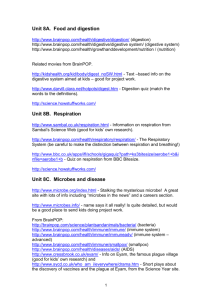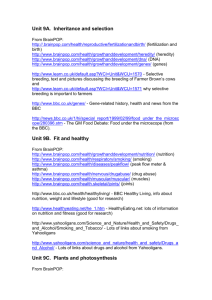Pts
advertisement
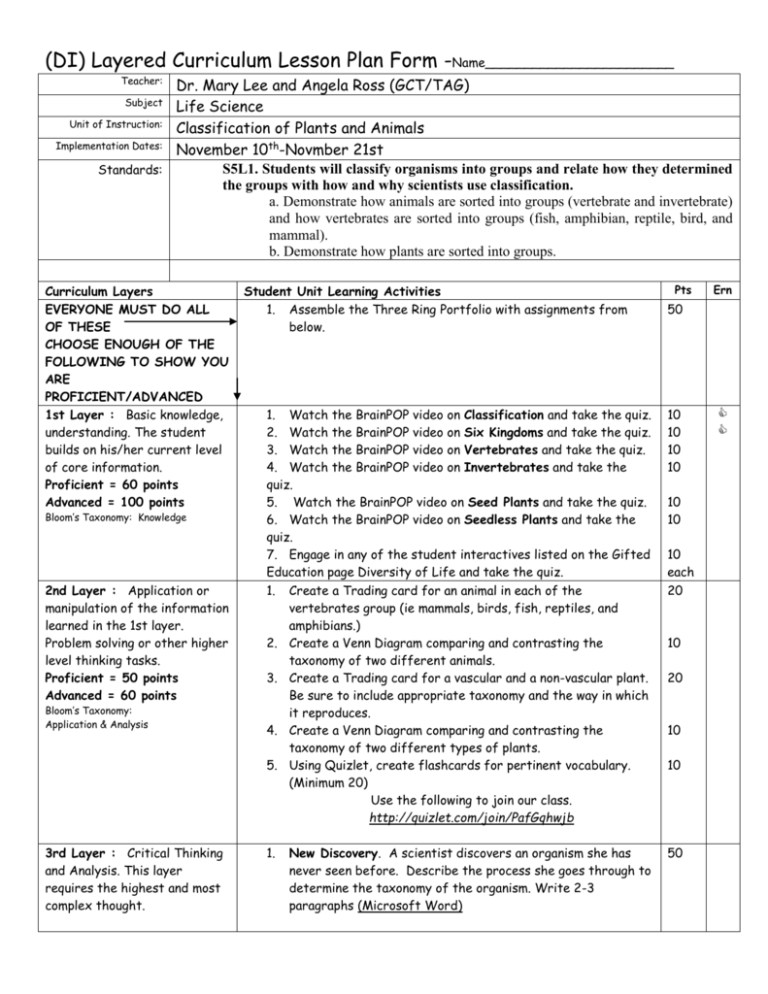
(DI) Layered Curriculum Lesson Plan Form -Name________________________ Teacher: Dr. Mary Lee and Angela Ross (GCT/TAG) Life Science Unit of Instruction: Classification of Plants and Animals Implementation Dates: November 10th-Novmber 21st S5L1. Students will classify organisms into groups and relate how they determined Standards: the groups with how and why scientists use classification. a. Demonstrate how animals are sorted into groups (vertebrate and invertebrate) and how vertebrates are sorted into groups (fish, amphibian, reptile, bird, and mammal). b. Demonstrate how plants are sorted into groups. Subject Curriculum Layers EVERYONE MUST DO ALL OF THESE CHOOSE ENOUGH OF THE FOLLOWING TO SHOW YOU ARE PROFICIENT/ADVANCED 1st Layer : Basic knowledge, understanding. The student builds on his/her current level of core information. Proficient = 60 points Advanced = 100 points Bloom’s Taxonomy: Knowledge 2nd Layer : Application or manipulation of the information learned in the 1st layer. Problem solving or other higher level thinking tasks. Proficient = 50 points Advanced = 60 points Bloom’s Taxonomy: Application & Analysis 3rd Layer : Critical Thinking and Analysis. This layer requires the highest and most complex thought. Student Unit Learning Activities 1. Assemble the Three Ring Portfolio with assignments from below. Pts 50 1. Watch the BrainPOP video on Classification and take the quiz. 2. Watch the BrainPOP video on Six Kingdoms and take the quiz. 3. Watch the BrainPOP video on Vertebrates and take the quiz. 4. Watch the BrainPOP video on Invertebrates and take the quiz. 5. Watch the BrainPOP video on Seed Plants and take the quiz. 6. Watch the BrainPOP video on Seedless Plants and take the quiz. 7. Engage in any of the student interactives listed on the Gifted Education page Diversity of Life and take the quiz. 1. Create a Trading card for an animal in each of the vertebrates group (ie mammals, birds, fish, reptiles, and amphibians.) 2. Create a Venn Diagram comparing and contrasting the taxonomy of two different animals. 3. Create a Trading card for a vascular and a non-vascular plant. Be sure to include appropriate taxonomy and the way in which it reproduces. 4. Create a Venn Diagram comparing and contrasting the taxonomy of two different types of plants. 5. Using Quizlet, create flashcards for pertinent vocabulary. (Minimum 20) Use the following to join our class. http://quizlet.com/join/PafGqhwjb 10 10 10 10 1. 50 New Discovery. A scientist discovers an organism she has never seen before. Describe the process she goes through to determine the taxonomy of the organism. Write 2-3 paragraphs (Microsoft Word) Ern 10 10 10 each 20 10 20 10 10 Choose one and complete for 50 points. Bloom’s Taxonomy: Synthesis & Evaluation 2. You have been named the curator of the new Diversity of Life Museum. The museum has six different galleries containing specimens from both the Plantae and Animalia kingdoms. Create a brochure that explains each gallery and specimens it contains. 3. Backyard Biology. Make a list of all the living plants and animals that can be found in your backyard/neighborhood. Survey to find out how many of each species are found there. Create a graph of the specimens. You choose the categories from your graph ie vertebrates/invertebrates; mammals, birds, fish, reptiles, and amphibians; vascular/non-vascular; seeded plants/seedless plants; etc. Be sure your graph has the appropriate labels and titles. Additionally, please interpret the data using 2-3 self-created questions ie What is the percentage of vertebrates found in my neighborhood? What is the percentage of seedless plants in my backyard? Etc. (Microsoft Excel) Less than 100=Does not Meet 100-210=Progressing 210-259= Proficient/Meets 260=Advanced/Exceeds Total Student Self-Reflection What did you enjoy most about this unit? What did you find most challenging about this unit? What would you do differently next time? What was the coolest/most interesting thing you learned? 50 50


